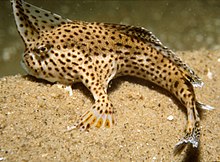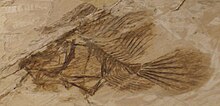
The River Derwent is a river located in Tasmania, Australia. It is also known by the palawa kani name timtumili minanya. The river rises in the state's Central Highlands at Lake St Clair, and descends more than 700 metres (2,300 ft) over a distance of more than 200 kilometres (120 mi), flowing through Hobart, the state's capital city, before emptying into Storm Bay and flowing into the Tasman Sea. The banks of the Derwent were once covered by forests and occupied by Aboriginal Tasmanians. European settlers farmed the area and during the 20th century many dams were built on its tributaries for the generation of hydro-electricity.

The Northern Pacific seastar is an invasive species in Australia.

Threatened fauna of Australia are those species and subspecies of birds, fish, frogs, insects, mammals, molluscs, crustaceans, and reptiles to be found in Australia that are in danger of becoming extinct. This article lists species classified as threatened species under the Commonwealth Environment Protection and Biodiversity Conservation Act 1999.

The spotted handfish is a rare Australian fish in the handfish family, Brachionichthyidae, classified as critically endangered on the IUCN Red List 2020. It has a highly restricted range, being found only in the estuary of Derwent River, Tasmania, and nearby areas, with the main threat to its existence being an invasive species, the Northern Pacific seastar.

Brachionichythys is a genus of marine ray-finned fish belonging to the family Brachionichthyidae, the handfishes. These fishes are confined to the southeastern Indian and southwestern Pacific Oceans off Australia.
An endangered species recovery plan, also known as a species recovery plan, species action plan, species conservation action, or simply recovery plan, is a document describing the current status, threats and intended methods for increasing rare and endangered species population sizes. Recovery plans act as a foundation from which to build a conservation effort to preserve animals which are under threat of extinction. More than 320 species have died out and the world is continuing a rate of 1 species becoming extinct every two years. Climate change is also linked to several issues relating to extinct species and animals' quality of life.
Brachiopsilus is a genus in the handfish family Brachionichthyidae.
Pezichthys is a genus in the handfish family Brachionichthyidae.

Thymichthys is a genus in the handfish family Brachionichthyidae. Like other handfishes, they move by means of walking on their pectoral fins, which resemble hands.
Sympterichthys is a genus in the handfish family Brachionichthyidae with these species:
Lophiomus is a monospecific genus of marine ray-finned fish belonging to the family, Lophiidae, the goose fishes, monkfishes or anglers. The only species in the genus is Lophiomus setigerus, the blackmouth angler, blackmouth goosefish, broadheaded angler or broadhead goosefish. This fish is found in the Indo-Pacific.
Peter Robert Last is an Australian ichthyologist, curator of the Australian National Fish Collection and a senior principal research scientist at CSIRO Marine and Atmospheric Research (CMAR) in Hobart, Tasmania. He is an elasmobranch expert and has described many new species of shark.

The red handfish is a species of handfish in the genus Thymichthys, found in Frederick Henry Bay, Tasmania.
Ziebell's handfish is a rare Australian handfish in the genus Brachiopsilus. It is known only from eastern and southern Tasmania. Ziebell's handfish may possibly be extinct, as there have been no confirmed sightings since 2007.

The smooth handfish is a possibly extinct species of handfish in the genus Sympterichthys. It was endemic to waters off the coast of Tasmania, mainly the D’Entrecasteaux Channel. It was declared extinct by the IUCN Red List in 2020, marking the first entirely marine fish classified as such. However, in 2021 its status was changed to Data Deficient due to uncertainties over the exhaustiveness of the unsuccessful surveys to find this species.
Moulton's handfish is an endangered species of handfish in the genus Sympterichthys. It is endemic to a few locations off the southeastern coast of Australia. It was first described as a distinct species in 2009 by Peter Last and Daniel Gledhill. It lives at a depth of around 105 metres (344 ft) - 150 metres (490 ft).

Gigantactis paxtoni is a species of fish in the whipnose angler (Gigantactinidae) family, first described in 1981 by Erik Bertelsen, Theodore Wells Pietsch III and Robert J. Lavenberg. The species epithet, paxtoni, honours John Paxton of the Australian Museum.
Gigantactis elsmani is a species of fish in the whipnose angler (Gigantactinidae) family, first described in 1981 by Erik Bertelsen, Theodore Wells Pietsch III and Robert J. Lavenberg. It has five dorsal soft rays and four to five anal soft rays.

Antennarioidei is a suborder of marine ray-finned fishes belonging to the order Lophiiformes, the anglerfishes.
The Australian spotted handfish is a species of marine ray-finned fish belonging to the family Brachionichthyidae, the handfishes. This species is endemic to eastern and southern Australia.













